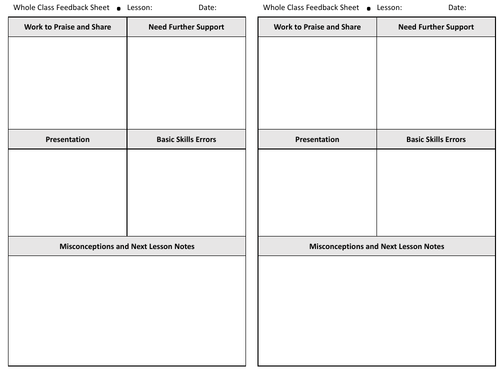5 December 2021

|
Whole School CPD Focus: |
Feedback and Questioning |
|
Walkthru Cluster: |
Feedback and Questioning |
|
Walkthru: |
‘Whole Class Feedback’ plus the Teacher Workbook
|
|
Starting Point |
Questioning and Feedback - YouTube
|
|
Reflections…
Whole-Class Feedback is an effective and time-efficient way of providing students with timely and detailed formative feedback. In his Walkthru, Sherrington suggests that this approach should be added to a repertoire of feedback strategies, rather than being used as a replacement for a particular type of written feedback.
Whilst minimising workload, this method allows the teacher to spend time reading the work in students’ books and allows time to process the knowledge that has been remembered and applied. By being released from the constraints of having to write feedback on every book (which can take several hours per set of books), class feedback allows the teacher to read all of the books and to then decipher the most effective feedback for the class.
So how can we adopt Whole Class Feedback within our classrooms?
Stage One: Read through Students’ work. The teacher would collect a set of books as usual. The teacher would then decide to focus on recent work or even a particular piece. This should happen before they next see the students that it informs the flow of ideas within the teaching sequence. As we all know, the more time that lapses between assessment and feedback, the less students remember about their experience of completing the work. By feeding back quickly, there is a higher probability that the student will consolidate their learning and make amendments and improvements next time. If time is an issue, a sample of books could be read in detail.
Stage Two: Note the Strengths. Identify common areas of strength and write them down. Sherrington suggests that this will reinforce the positives whilst also prompting those that haven’t included them. Specific examples also work well here to exemplify these strengths in practice.
Stage Three: Note Areas for Improvement. The key word here is ‘note’. Succinct, manageable lists of improvements are crucial here. Empathy also plays a key role; how would a student feel if they received a vast list of improvements; overwhelmed? Confused? There have been examples of class feedback shared via edu--blogs whereby student names are attached to the errors, although this can knock confidence. It does, however, pay-off to note down names of students who might benefit from a dialogue about their errors.
Stage Four: Give the Feedback. In the next lesson, the work should be returned to students and the whole-class feedback should be presented to the class. Strengths, areas for improvements (and possibly common SPaG errors) should be highlighted. Visualisers work well here, as pre-selected WAGOLLs could be used to exemplify strengths. Photographs of work pasted into a PowerPoint also work well.
Stage Five: Give Improvement Time. This is key to ensuring that progress is made. Sherrington proposes that students are given time in lesson to act on the feedback given and to make improvements needed. They should highlight where in their work the common errors occur and then they should use red pen to improve them. Hopefully, this will force them to think hard about their own work. At this point, the teacher should be employed circulating and discussing improvements with students (perhaps those noted down in stage 3 of the Walkthru).
This Walkthru is already a key element of feedback within the Humanities and English Departments. If you are interested in seeing how this works in practice, then speak to a member of those departments.
|
|
|
CPD Cascade |
RLO – Cold-Calling Reflections https://classteaching.wordpress.com/2021/10/21/reflections-on-cold-calling/
RHO – Sherrington’s Checking for Understanding 7 Principles of Effective Feedback (RHO)from Teacher Toolkit
https://www.youtube.com/watch?v=v3UazBMmwVA Mini-whiteboard tips (RHO)https://www.johntomsett.com/2021/10/17/this-much-i-know-about-how-to-get-better-at-using-mini-whiteboards-in-your-classroom/Sexual Harassment and Gender StereotypingFree online training to tackle sexual harassment, language and gender stereotyping. https://training.ukfeminista.org.uk/ National CollegeRemember that there are subject-specific watchlists available in National College.
|
Posted by Rachel Long
Category: Teaching and Learning Digests
